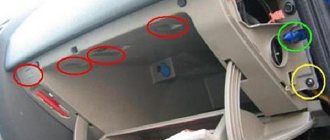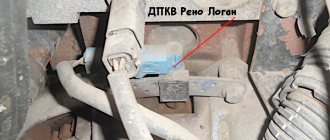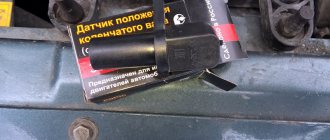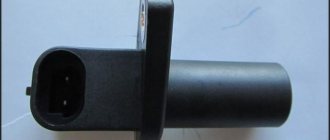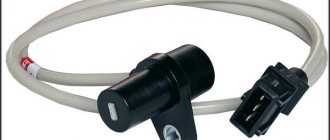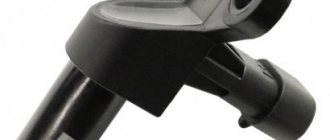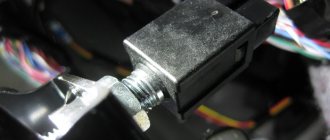Modern vehicles are equipped with an electronic control unit. It is the “brain” of the car. The process of starting the engine will directly depend on it. Also, with its help, the driver receives information about the condition of a particular unit. Manufacturers equip machines with measuring instruments to monitor the performance of the main components. One of these controllers is the crankshaft sensor on the Renault Megane 2. If it fails, the engine will not be able to operate normally, and the vehicle simply will not move.
Idle mode of an injection engine
The ECM (electronic engine management system) is responsible for maintaining idle speed at the required level.
The ECM control unit (ECU), based on data received from various sensors, determines the amount and duration of fuel injection by injectors at idle, controls the idle speed regulator, and also sets the desired ignition timing required to maintain a certain crankshaft speed. The order of operation of an injection engine in idle mode using the example of engine 2111 of VAZ 21083, 21093, 21099 cars
— Before turning on the ignition, the idle air control rod (IAC) is extended to its maximum and completely covers the cross-section of the bypass (air) channel in the throttle assembly.
— After turning the key in the ignition switch, the ECU determines the temperature of the coolant (signal from the temperature sensor - DT), determines that the throttle valve is completely closed (signal from the throttle position sensor TPS), the car is standing or driving (signal from the speed sensor - DS) .
Based on the data obtained, the position of the idle speed control rod is calculated at which it slightly opens the bypass channel to a certain clearance, which ensures the flow of air necessary for the engine to idle.
— After starting the engine, the control unit receives information from the crankshaft position sensor (CPS) about its rotation, from the temperature sensor about the coolant temperature, from the throttle position sensor that the damper is closed, from the mass air flow sensor (MAF) about the volume of incoming air into the engine, from the speed sensor about whether the car is standing or moving.
Based on the data received, the control unit sets the IAC rod to a position that provides optimal clearance of the air channel under the throttle valve. This ensures the flow of air into the engine cylinders necessary to maintain minimum stable speeds. In addition, it determines the duration and amount of fuel injection through the injectors, and determines the ignition timing.
As the engine warms up, the temperature of the engine increases, the temperature sensor signals this to the control unit and it moves the idle speed control rod, reducing the clearance of the air channel. The magnitude and duration of injection are reduced, and the ignition timing changes. The crankshaft speed gradually drops to 650-750 rpm.
If a warm engine starts and idles, then in the same way, based on the data received from the sensors, the control unit sets the regulator rod to the desired position.
In systems with feedback, the magnitude and duration of injection, and the ignition timing are calculated taking into account the readings of the oxygen sensor (poor-rich mixture). On a cold engine, the oxygen sensor does not work; readings from it begin to be taken as the engine warms up.
When you press the gas pedal, the throttle valve opens slightly, and the TPS signal about this is sent to the control unit. The engine idle mode stops. The regulator rod is set in such a position that when the throttle valve is suddenly closed, it quickly ensures the flow of additional air into the engine through the air duct and prevents “failure” in its operation.
If the car is moving with the gear engaged and the throttle completely closed (downhill, on a flat area, when braking with the engine, while changing gears), the ECU switches the system to forced idle mode (FIL) (fuel does not flow into the engine, it operates by inertia ).
Notes and additions
— Idle speed of a car engine is operation at low speeds (650-750 for injection VAZ 21083, 21093, 21099) with the throttle valve fully closed.
— In the event of a malfunction of the IAC, it is worth checking its electrical part.
Source
How does the sensor work?
To learn how to troubleshoot the specified device, you need to understand its design and understand the principle of operation. The sensor design is simple and includes the following elements:
- multi-turn coil;
- magnetic core;
- the coil leads are soldered to the connector contacts;
- non-separable plastic case with a hole for fastening.
The meter is installed in close proximity to the toothed pulley attached to the crankshaft on the timing gear side. Through conductors, the sensor is connected to the main electronic unit that controls the operation of the motor.
The magnetic core is brought out through the end part of the plastic case and is as close as possible to the teeth of the rotating pulley. The gap between the parts does not exceed 1 mm.
The operating principle of the device is based on the phenomenon of electromagnetic induction. When a significant mass of metal passes in close proximity to the core, the coil generates a short-term electrical impulse. The teeth of the rotating pulley cause a series of such impulses, transmitted through the wires to the controller. Thanks to this, the electronic unit always “knows” the position of the crankshaft, determines the top dead centers of all pistons and promptly sends a command to the injectors to inject fuel.
This is where the second name of the device came from – crankshaft speed sensor. It must be understood that impulses are generated only under the dynamic influence of the metal mass, that is, when the pulley rotates. If the crankshaft has stopped, no current occurs in the element circuit.
Why do you need a recreation center?
The sensor is required to determine the following engine performance readings:
- recording the moment when the pistons pass the top and bottom dead centers in cylinders 1 and 4;
- fixing the position of the crankshaft;
- fixing the crankshaft speed;
When data is recorded, the measuring device transmits it to the electronic control unit. In turn, the electronic control unit processes the information and synchronizes with the working strokes of the engine.
We replace the sensor in the following sequence:
1. Remove the decorative trim of the engine (if there is one).
2. Using a slotted screwdriver, carefully lift the latch and remove the connector from the sensor.
3. CAREFULLY prying with a slotted screwdriver from different sides, gradually remove and remove the sensor.
4. Install the new sensor in reverse order.
Next, for comparison, I am posting photographs showing the original sensor and the NP51106141 sensor.
As you can see, the sensors are identical. I don’t think that the vacuum supply pipe on the original sensor is completely broken off. It’s just that when removing the sensor from the receiver, I had to break it off completely, otherwise there was no way to remove it.
I hope this information will be useful for you!!! Thank you for your attention!
Crankshaft sensor for Renault Megane II LM0/1 Sedan 1.6 113 HP id17726
Manufacturer: BOSCH Germany
Article number:0 986 280 410
- Manufacturer: FAE Spain
- Article:79298
- Number of poles:3
- Sensor type: hall sensor
Manufacturer: FACET Italy
Article number:9.0543K
- Manufacturer: ERAItaly
- Article:550537
- Resistance [Ohm]:230
- Height [mm]:24
- For article no.:550537
- Number of connections:2
Manufacturer: BOSCH Germany
Article number:0 986 280 433
- Manufacturer:MOBILETRONTaiwan
- Article:CS-E013
- Number of poles:2
Manufacturer: FAE Spain
Article:79028
- Manufacturer:HOFFERItaly
- Article:7517401
- Additional article / Add. information 2:no cable
- Sensor type: hall sensor
- Number of poles:3
- Height [mm]:28
Manufacturer: FACET Italy
Article:9.0543
- Manufacturer:MOBILETRONTaiwan
- Article:CS-E003
- Number of poles:2
- Manufacturer: OPTIMALGermany
- Article:07-S034
- Sensor type:passive sensor
- Additional article / Add. Information 2: Without vehicle-specific adapter
- Equipment/equipment: for vehicles with automatic transmission
- Number of poles:2
Manufacturer: DELPHIUSA
Article:SS10803
Pages:
Search, removal and installation
According to the functionality, the crankshaft sensor is located near the connection between the automatic transmission box and the car engine. To get to it, you need to remove the air conditioner inlet and filter housing. The position of the device at a dead center indicates the need for cleaning or replacement.
Although it is worth noting that on Renault Megane II with an engine capacity of 2.0 rather than 1.6, the crankshaft and sensor are located in a slightly different place - under the battery. And its removal and replacement are carried out using a pit or a lift, i.e. from below the car. To remove the sensor you will need the following tools:
- extension cords;
- cardan coupling;
- a wrench with a head of at least 10, but preferably 11 mm, and ideally about 1 meter long;
- if necessary, carrying for better lighting.
First of all, we remove the battery pad. Next, using a thin slotted screwdriver, separate the connector retainer and the wire block. If difficulties arise, then simply move the block as long as the length of the wires is enough, then the process of removing the block will not be difficult
Now you need to unscrew the two mounting bolts and remove the device. It is important not to lose the rubber gasket and make a note of where it was installed. If necessary, clean or replace the sensor
Cleaning it is not difficult, you just need to wipe it with a clean rag soaked in gasoline. Often this helps and the problem can be solved in this simple way. However, in any case, be careful when cleaning - this is a rather fragile element.
After installing the device, it is necessary to configure the programming of the toothed section of the flywheel. This is done by decelerating twice in sequence in third gear at a maximum speed of 4,000 rpm. Until the fuel is supplied again, which indicates normal operation of the ECU.
If malfunctions are found, they must be eliminated according to the instructions and make sure that the machine is fully operational.
Replacing the sensor is not problematic; even a novice car enthusiast can do this after reading the instructions. The difficulty, as was said at the beginning of the article, is the differences in engine models on Megan and also the differences in models and locations of the crankshaft sensor itself. Although since 1985 it has been available in the only current form: 8200673202 and 8200647554.
Required Tools
To replace the crankshaft position sensor on Megan 2 with your own hands, you need the tools from the list given in the table below.
Table - Tools required to replace the crankshaft sensor
| Name | Note |
| Spanner | Set |
| Head | "on 10" |
| Screwdriver | Medium size, flat blade |
| Vorotok | With ratchet and extension |
| Penetrating lubricant | For releasing rusted threaded connections |
| Rags and wire brush | For cleaning work surfaces from dirt |
Signs of sensor problems
The crankshaft speed meter is considered a fairly reliable device, functioning properly for 100 thousand km or more. There are often cases when an element lasts the entire service life of the car. A crankshaft sensor malfunction may occur for the following reasons:
- An internal break or short circuit of the coil winding occurs due to prolonged exposure to vibration transmitted from the engine. Such a breakdown is very rare.
- Open circuit between the device and the controller. The reasons are the same vibration, melting of conductors from contact with hot parts of the engine, or accidental damage by a car enthusiast.
- Mechanical destruction of the body occurs during repairs carried out in the engine compartment. For example, being hit by a broken wrench.
- Loss of contact in the connector due to oxidation or loosening.
- Contamination of the working surface interacting with the toothed pulley.
The last item on the list requires a separate explanation. It is common knowledge that electromagnetic fields penetrate dielectric materials, including dust and dirt. But at the location of the sensor, small metal particles and chips flying from gears are added to traditional contaminants. When they hit the end of the core, they shield the magnetic field, causing the electrical pulse to gradually weaken.
How a car owner can identify the symptoms of a sensor malfunction:
- When the element completely fails, the engine stalls and does not show signs of “life” during subsequent attempts to start, since the controller does not “see” the position of the crankshaft. A broken electrical circuit gives a similar result.
- Unstable operation at idle. The engine speed “jumps” and vibration of the power unit is observed.
- Loss of power from the power unit, failures during acceleration.
- Increased consumption of gasoline or diesel fuel.
As strange as it may sound, the first sign is the most favorable. It is much easier to revive a “dead” motor - just check the circuit or change the sensor itself. In case of unreliable contact and other minor troubles, the engine does not fail, but behaves unstable. The problem is that if other sensors fail and the ignition system malfunctions, the power unit behaves in the same way and identifying the real malfunction is much more difficult.
When the air flow sensor, throttle position sensor or lambda probe is faulty, the control unit switches to emergency mode, supplying fuel according to average indicators. This results in unstable operation and increased consumption. The same symptoms are observed when there is a problem in the crankshaft speed meter circuit.
Electronics
- Glitch in the ECU with engine speed in cold weather. The speed immediately rises, and then drops sharply and hangs at around 400 rpm.
- If the car has a Valeo generator, then after 60 thousand km, it very often fails (the problem is either in the regulator relay or brushes).
- At 60 thousand kilometers, the airbag train breaks off in the steering column. Since you can only buy it complete with a steering switch for $200, the best option may only be to resolder the cable. A sign that the plume will soon close and the airbag light will come on is a rustling sound when the steering wheel is turned.
- On cars older than 2006, in wet weather miracles can often happen to the electronics; in particular, the image on the on-board display may disappear.
- Closer to 60-80 thousand km. The power windows may fail, often the front windows will fail (they are used the most). Due to the destruction of the jumper in the gearbox housing or the drum with the cable wears out.
- The windshield wiper motor may burn out (due to its location). When the water drainage hole in front of the windshield becomes clogged, it floods the motor.
Engine Variations
Replacing the crankshaft sensor on cars differs only in engine models. Let's look at engines for Renault Megane 1 and 2.
- Type E, engine E7J, fuel – gasoline, 1.4 liters. In operation since 1988, i.e. most often found on Megane I. Designation “Energie-Motor”. The main difference is the V-shaped distribution of the intake and exhaust valves, as well as the designed cylinder block, with different directions of inlet and outlet of fuel-air mixture and exhaust gases - which ensures rapid gas exchange. The crankshaft is located at the bottom of the engine. It is connected by connecting rods to the pistons.
- Engine Renault Megane type F, petrol F3R/F4R or diesel F8Q/F9Q 2.0 liters. This is an earlier engine model that has been in service since the early 80's. Just like in the E engine, the crankshaft is located at the bottom. A more powerful engine, but has difficulties in repairing and installing its elements.
- Gasoline engine Renault Megane type K 1.6 liters. An improved version of the E-modification, where the dimensions for the pistons are increased and, accordingly, the volume is increased from 1.4 to 1.6 liters, without changing the engine dimensions. Designed for Renault Megane second generation. Both Megan models, both 1.4 and 1.6 liters, are 16-valve. The electronic ignition system is automated and does not require maintenance from you during use. The presence of separate coils for each cylinder in the corresponding spark plug, without a wire connecting them.
- Renault Megane 1.9 liter dCi diesel engine with direct fuel injection. A distinctive feature is the adjustment for different moments of movement of fuel injection into the combustion chambers.
Although different engine models can be used in a car, their essence is always the same. If the car does not start, there may be several reasons for this, and one of the main ones may be contamination or damage to the sensor.
According to statistics, the crankshaft sensor fails quite rarely, but this is a clear reason for the inability to use any car, including the Renault Megane. The cause is often corrosion of the wiring, rather than damage to mechanical moving parts, since they simply are not there.
But it is still susceptible to mechanical damage, for example, the body of the device may crack or it may “move” a little from the desired position.
Its functional purpose is to read the dynamics of crankshaft torsion and create alternating current pulses with the transmission of information to the vehicle control unit (ECU).
Transmission
- After 60 thousand km, a whistling sound from the release bearing on the secondary shaft may appear.
- Also, for most owners, after a mileage of 60,000 km, box kicks appear through a worn clutch disc; its lifespan is short. And replacing a new clutch for longer than 50 thousand is also not enough. The clutch disc from the Scenic performed much better.
- On automatic transmissions, after 40 thousand, the valves in the hydraulic distributor become clogged (mainly depends on driving style).
- Field 60 thousand km there is a high probability of early failure of the automatic transmission cushion.
Why the valve jams and how to clean it
As mentioned above, contamination of the phase shifter valve can cause it to jam, which affects engine performance, vehicle dynamics and fuel consumption. The cause of blockage is most often dirt that penetrates into the device through a damaged oil seal. Dust mixed with engine oil gets into the gap between the housing and the rod, causing the latter to begin to jam. In addition, damage or wear to the plastic vanes of the phase regulator can contribute to jamming. In this case, soft chips are guaranteed to get into the channels of the device and with a high degree of probability can cause it to jam.
Cleaning the phasor valve is easy - you don’t even have to disassemble the device to do this. First of all, remove the protective mesh that is installed on the inlet channel. It is made in the form of a spring ring, which is easily unclenched and removed from the body. Using any suitable spray cleaner (carburetor, brake, injector, etc.), wash the valve body and internal passages. Then you need to dry the parts with compressed air - it is best supplied through the outlet channel. Next, the solenoid terminal is connected to a power source and, using the method described above, the accuracy of operation and complete opening of the valve are checked.
In particularly advanced cases, flushing may not help. Then you will have to flare the housing, disassemble the device and thoroughly clean the Renault Megane 2 phase regulator valve.
After washing and checking the functionality of the valve, it is necessary to install a protective mesh in the groove. Experts recommend carefully melting the edges of its joint with a soldering iron - this will protect the filter ring from moving. All that remains is to return the oil seal to its place and install the valve on the engine.
As you can see, there is no reason to be afraid of error DF080 - even a beginner can cope with the problem. As for malfunctions such as valve jamming or wear of phase shifter parts, it is much easier to prevent them than to eliminate them
Attention to little things like an oil stain around the valve will allow you to restore its tightness in time, which will certainly affect the health of the engine and help save the family budget
Methods of checking in garage conditions
The simplest and least labor-intensive way to check for a unit malfunction is diagnostics using diagnostic equipment. Diagnostic time takes no more than 5 minutes, and there is no need to go into the engine compartment. The range of diagnostic devices on the market is huge, both in functionality and pricing. Among budget devices, we can recommend a car diagnostic scanner, made in Korea – Scan Tool Pro Black Edition.
According to our personal experience, this device, despite its low price in the region of 1950 - 2500 rubles. is able to diagnose the general condition of the car by displaying error codes with their descriptions, as well as the operation of various sensors in real time. The auto scanner has a compact size and is connected via the OBD-2 diagnostic connector. Data transfer is carried out to any modern device - smartphones, tablets, PCs running Android, iOS and Windows OS.
If you do not have such adapters, then you need to remove the sensor and perform the diagnostics described below:
Thoroughly clean the device body with a rag moistened with an organic solvent - white spirit, turpentine or other degreaser.
Pay special attention to the end facing the toothed pulley. Make sure the fastening is secure. Due to a loose screw, the sensor may move away from the metal teeth, as a result, the gap will increase and the generated pulse will weaken. Clean the connector contacts from oxidation. Inspect the wiring for melting or breakage.
If the above actions do not produce results, the crankshaft sensor is dismantled and checked with a multimeter in 2 stages. At the first, the resistance between the terminals of the device is measured, which makes it possible to verify the integrity of the induction winding. Clean the contacts, turn on the ohmmeter and check the resistance between them. Normal readings are in the range of 500–700 Ohms; if the turns are shorted, you will get a zero or reduced value; if there is a break, you will get infinity.
At the second stage, the performance of the element is tested according to step-by-step instructions:
- Switch the multimeter to voltage measurement mode, the maximum threshold is 200 millivolts.
- Securely attach the wires to the contacts of the sensor block (for example, with alligator clips).
- Take any metal tool - a wrench, a large screwdriver or something similar. Apply and tear it sharply from the magnetic core of the element, holding the body with your hand. The voltmeter should show voltage surges.
Further actions are as follows: the broken crankshaft speed meter is replaced with a new one; the part cannot be repaired. The working sensor is installed back, maintaining the gap, and the troubleshooting continues in another place.
A few words about how to check the crankshaft sensor on the road when you don’t have a multimeter or other diagnostic tools. You will need 2 wires and an LED light bulb from any car lamp (for example, an interior lamp). For convenience, unscrew the element and connect the lamp to the connector, then apply a wrench to the magnet, as described above. A working sensor will cause the LED to flash.
https://youtube.com/watch?v=zRlOqO1pK24
Diagnostics of the Renault Megane 2 engine management system
04/05/2017 ENGINE
The engine management system on the Renault Megane 2 has a self-diagnosis mode. During operation, the electronic control unit (ECU) monitors the serviceability of all elements and circuits of the engine control system. Having detected a malfunction, the ECU switches the engine management system to standby mode and turns on the corresponding malfunction indicator lamp located on the instrument panel.
In most cases, the engine will be able to continue working, which allows you to get to the repair site under your own power, but with a deterioration in the vehicle’s operational parameters. Detected fault codes are stored in the memory of the engine management ECU.
To read fault codes, the system has a diagnostic connector installed in the lower part of the center console and closed with a cover.
Diagnostic connector standard OBD II.
You can read fault codes using a special scanner at a service center or yourself, if you have the appropriate equipment.
Diagnostic connector contacts for Renault Megane 2
| Contact number | Symbol | Assigning contacts |
| 1 | AP46 | Supply voltage +12 V (from ignition switch) |
| 4 | MAM | "Weight" |
| 5 | NAM | "Weight" |
| 6 | 133B | Signal (CAN H bus) |
| 7 | H.K. | Diagnostic signal K |
| 14 | 133C | Signal (CAN L bus) |
| 16 | BP32 | Supply voltage +12 V (from battery) |
Note: Via the diagnostic connector, you can read fault codes for other systems of the Renault Megane 2 (transmission, ABS, electric power steering).
Location
Where is the crankshaft sensor on Renault Megane 2: this question is often asked by drivers who have recently used a vehicle of this brand. Since the device is important, the manufacturer has made it easier to access and installed a measuring controller on the left end of the cylinder block. A conductor extends from it, reaches a length of 70 cm and connects directly to the electronic control unit.
Location depending on the gearbox used on Renault Megane 2:
- if the car has a manual transmission, the sensor is located near the left cylinder block in the clutch housing;
- If the vehicle is equipped with an automatic transmission, the controller is installed near the left cylinder block in the gearbox housing.
